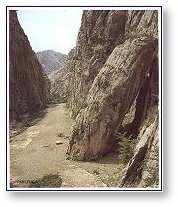
 To Main page
To Main page
 About the trip
About the trip
 Contact
Contact
|

Region:
In 1978, as part of the UNESCO Man and the Biosphere (MAB) Program,
Mt Velebit was proclaimed a world biosphere reserve. The Paklenica National
Park is located on the southern slopes of the Velebit massif, immediately
below its highest peak (Vaganski vrh or peak, 1758 m). Administratively,
it is within the area of the city of Zadar, while the headquarters of
the park's management is in Starigrad Paklenica. Paklenica is a particularly
interesting part of Velebit by reason of its richness of natural beauties,
its karst phenomena, its water features and abundance of flora and fauna;
in 1949 it was proclaimed a national park.
Magnitude: 
The total area of the Paklenica National Park is 3,617 hectares. It
takes in mostly the catchment area of the boisterous rivers the Velika
and Mala Paklenica, which surround the highest peaks of the
southern Velebit and drop through the Velika and Mala Paklenica gorges
right down to the vicinity of the sea above Starigrad and Selin.
A description of the park:
In geomorphological terms the region of the National Park is made up
of an elongated valley (about 8.5 km long), which follows the direction
of the principal ridge of Mt Velebit, and the two shorter canyons (4
- 5 km long) of Velika and Mala Paklenica, which cut vertically across
the Velebit massif. Here there are surface water courses the whole year
round and, in addition, the valleys of winterbornes. Through tectonic
upheavals and the erosive action of the torrents, the lower parts of
the valleys take the shapes of majestic canyons with deeply incised
steep cliffs up to 400 metres high. The most imposing rock, Anica
kuk (715 m) is a famed spot for climbing. A special richness is
given to the karst of Paklenica by the subterranean natural beauties
of the many caverns and pot-holes (Manita pea, Jama vodarica and others).
Most of the area of the National Park is covered by forest, which constitutes
a green oasis in the vicinity of the sea. Part of the forest
is still in its virgin form. Because of its geographical position and
variations in altitude, there is a great diversity of vegetation in
the park. There is the stone scrub and maquis of the coastal region,
then broad, low woods that become high forests in the interior.  Above them are forests of beech and juniper,
and then mountain meadows abounding in wild flowers stretching way up
to the highest peaks. Beech forests cover the widest areas, followed
by forests of Austrian pine. The most important inhabitant of Paklenica
is certainly the bear. Also living here are wolves, martens, wildcats,
deer, rabbits and many small rodents, the golden eagle, the stock dove,
the hobby, the raven, the long-eared owl, the griffon vulture and many
other birds. Maritime and continental influences impart special features
to the Park and the close vicinity. While the coastal part of the Park
has a cooler type of Mediterranean climate, the interior is characterised
by a continental climate, and in the upper parts a sub-Alpine climate
prevails. This very attractive combination of influences also provides
ideal conditions for holiday-making in the coastal region close to the
Park. Above them are forests of beech and juniper,
and then mountain meadows abounding in wild flowers stretching way up
to the highest peaks. Beech forests cover the widest areas, followed
by forests of Austrian pine. The most important inhabitant of Paklenica
is certainly the bear. Also living here are wolves, martens, wildcats,
deer, rabbits and many small rodents, the golden eagle, the stock dove,
the hobby, the raven, the long-eared owl, the griffon vulture and many
other birds. Maritime and continental influences impart special features
to the Park and the close vicinity. While the coastal part of the Park
has a cooler type of Mediterranean climate, the interior is characterised
by a continental climate, and in the upper parts a sub-Alpine climate
prevails. This very attractive combination of influences also provides
ideal conditions for holiday-making in the coastal region close to the
Park.
|